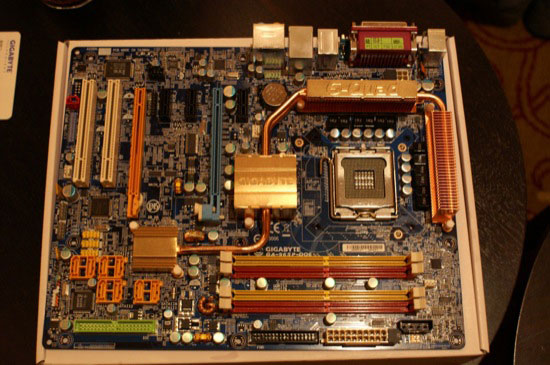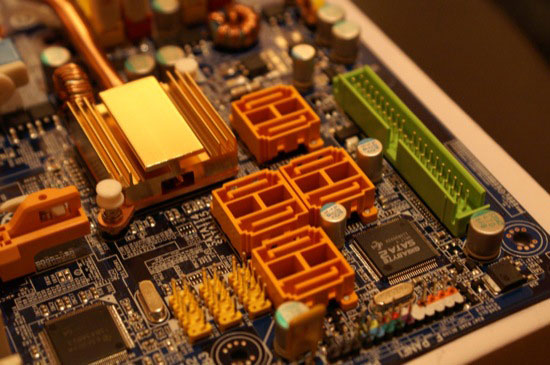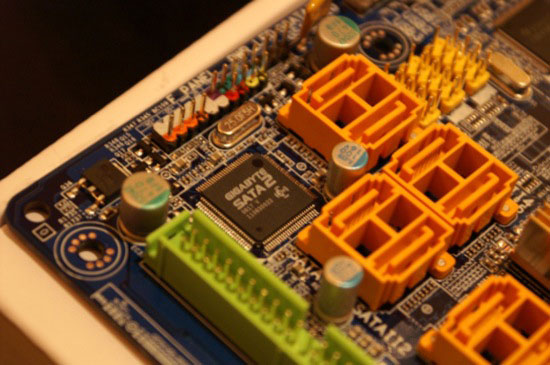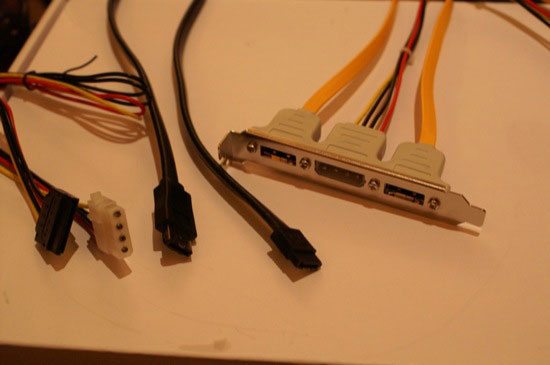Computex 2006: 300W GPUs, Conroe, HDMI Video Cards and Lots of Motherboards
by Anand Lal Shimpi on June 5, 2006 10:24 PM EST- Posted in
- Trade Shows
Gigabyte's Conroe Motherboard
Using the P965 chipset (Broadwater), Gigabyte showed us its flagship Conroe motherboard. The P965 chipset only supports one PCIe x16 slot and one x4; the blue slot below is the x16 and the orange slot is the x4:
 |
| Click to enlarge |
Six of the SATA ports are courtesy of Intel's ICH8R, the other two are made possible by the relabled JMicron SATA/PATA controller that you see in the picture above. The Gigabyte "SATA2" chip (actually a JMicron chip) provides support for the two SATA ports and the lone PATA port you see in the picture above. Remember, Intel's ICH8R doesn't support any PATA ports natively so you will see all motherboard manufacturers resorting to a similar sort of arrangement.
Gigabyte outfitted its P965 motherboard with a 12-phase power design, designed to support Kentsfield. This board has already been tested to work with Kentsfield, although Gigabyte's competitors insist that a 12-phase power design is not necessary for Kentsfield.
You'll notice that all of the capacitors on the motherboard are similar to those around the CPU in that they are not standard electrolytic capacitors filled with liquid. All of the capacitors used on the Gigabyte board use a solid chemical compound designed to better withstand higher temperatures, thus preventing leaking or other capacitor related failures. The more expensive capactiors raise the price of the motherboard by a healhty $20. Gigabyte still only offers a 3-year warranty on this board, despite the technically more reliable capacitors.
Gigabyte is simply trying out the more expensive caps on this motherboard, if the demand is high enough you may see a similar setup on high end AMD motherboards as well. Gigabyte's competitors insist that the more expensive caps aren't necessary across the motherboard and that this is simply a gimmick.
Gigabyte also ships this motherboard with two external SATA brackets that convert internal SATA ports into ports that can be used outside of your system. Gigabyte's brackets also provide 4-pin power for powering internal hard drives outside of your case.














61 Comments
View All Comments
Missing Ghost - Monday, June 5, 2006 - link
wow, all I can say is wow. I am quite impressed with Gigabyte desktop motherboards. From the pictures it looks like a better design than even what DFI would do. Also the ASUS socket F board looks excellent. Quite impressive since I am used to think that ASUS' server boards are inferior to like supermicro/iwill/tyan.krwilsonn - Monday, June 5, 2006 - link
Page 18 of the article seems to be mixed up since the Albatron boards are showing up instead of the Asrock.Regs - Monday, June 5, 2006 - link
Actually consider what AMD is doing at all. Boy times have changed! ;)I'm a life long AMD fan too. Short life, but life long.
bob661 - Monday, June 5, 2006 - link
Where have you been? It's been like that for quite a few years now. Remember when DDR2 was actually on the market? Who wasn't using DDR2 then?bob661 - Monday, June 5, 2006 - link
Figures.bob661 - Monday, June 5, 2006 - link
Interesting. Looks like Conroe's may come at a premium until Intel can increase production.shabby - Monday, June 5, 2006 - link
I dont get it, what is the point of sending audio to the monitor?
Furen - Monday, June 5, 2006 - link
It's meant to be sent to an HD TV. Monitors can just use DVI for digital signaling.shabby - Tuesday, June 6, 2006 - link
And whats the point of that too? Its supposed to go to the reciever not the tv.OrSin - Tuesday, June 6, 2006 - link
Do you even know why hdmi exist. Most HDTV that have HDMI connects also has audio out.YOu connect everything to your tv and send out only singles you need. My guess is you don't have a HDTV.